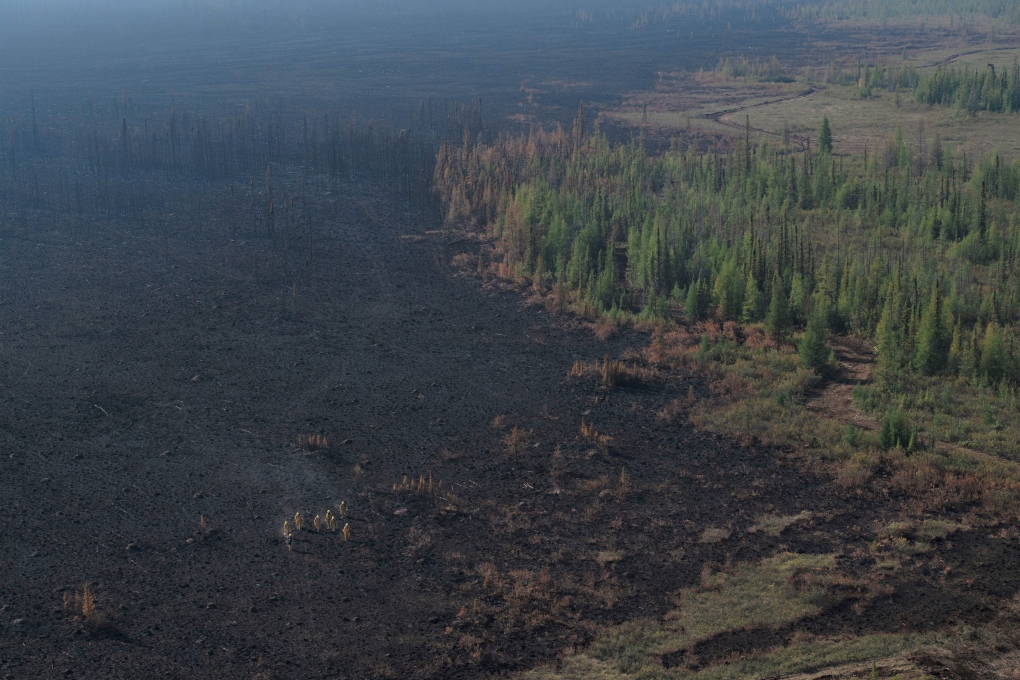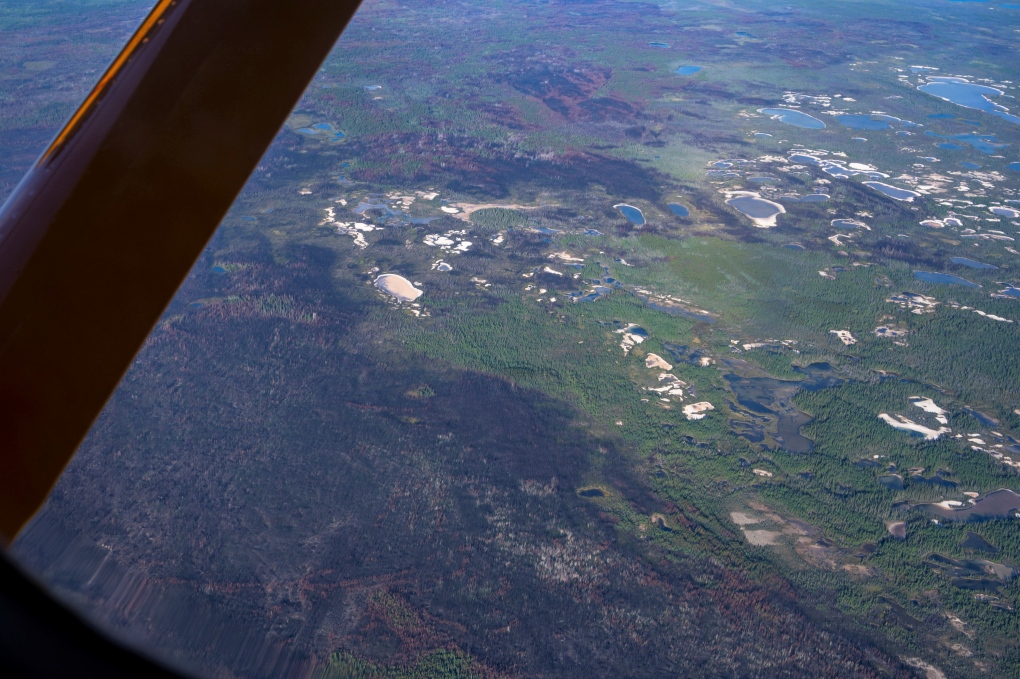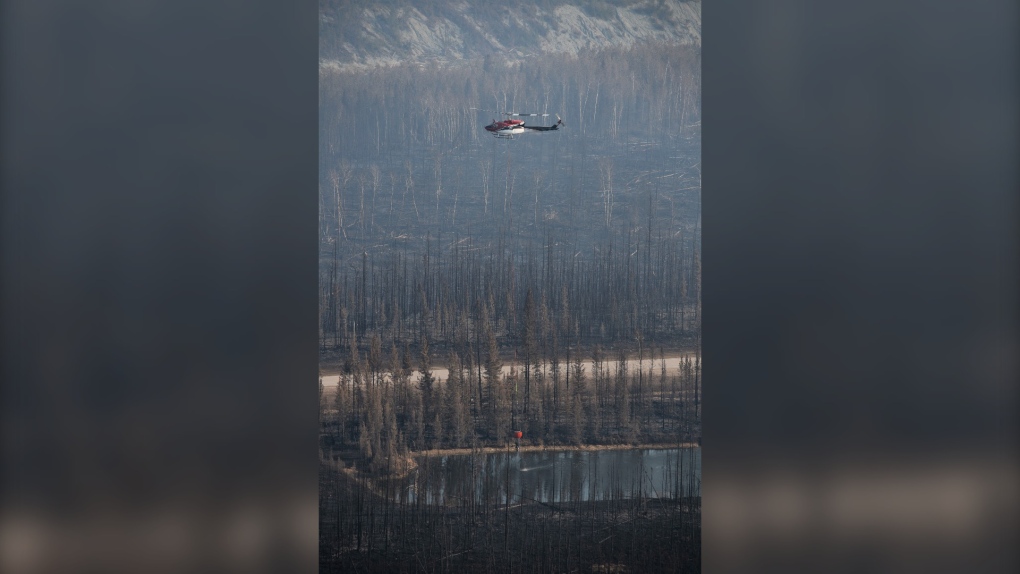Over the summer, wildfires impacted almost every province and territory across Canada.
Flames spread rapidly across forests leaving in their wake bare, thin blackened trees that appear desolate.
But in reality, even the areas most damaged by wildfires have bits of life that will be the nucleus of regrowth, John Clague, emeritus professor at Simon Fraser University said.
"A wildfire will not burn everything, surprisingly," Clague told CTVNews.ca in an interview. "I appreciate the fact that when you look at those images, it looks like everything is burned, but there often are little patches (left untouched)."
Hidden underneath burned logs and dirt, seeds from fallen trees can be found which begin the process of regrowth almost immediately after a fire has gone through.
Clague says first ground shrubs will establish and take over within one to two years post-fire. These plants are "sun-loving" and grow quickly since there are no overhead trees anymore to shade them.
 Scorched trees mark the banks of Hay River, NWT on 21 August 2023. (Lt(N) Alex Roy, Canadian Armed Forces)
Scorched trees mark the banks of Hay River, NWT on 21 August 2023. (Lt(N) Alex Roy, Canadian Armed Forces)
Wildfires can occur, depending on conditions, in any forested part of Canada, but are fairly common in the boreal forest.
This stretch of land extends from Alaska across most of Yukon, the Northwest Territories and parts of southern Nunavut. It touches the northern parts of British Columbia, Alberta, Saskatchewan, most of Manitoba, northern Ontario, Quebec and Newfoundland and Labrador.
WHAT TREES ARE HIGHLY FLAMMABLE?
Pine, spruce and other coniferous trees are extremely common and make up the majority of the boreal forest in Canada.
Clague says these forests are "tight" and dense. Spruce for example is very common in N.W.T. which saw increased fire activity this year due to drought conditions.
Mike Westwick, a fire information officer with N.W.T. fire, told CTVNews.ca in an email, "One of the things which makes the boreal forest especially conducive to wildfire is the abundance of black spruce and pine — both of which are highly flammable."
Other common trees found in the area include a variety of birch, firs, tamaracks, aspen and poplar, among others.
"These are trees that are well adapted to cold winter climates and drier warmer summer months," Clague said. "They are happy campers in that environment."
 Members of B Company, 2nd Battalion, Royal 22e Régiment, conduct Type III firefighting operations in the vicinity of Hay River, NWT in support of Operation LENTUS on 21 August 2023. (Lt(N) Alex Roy, Canadian Armed Forces Photo)
Members of B Company, 2nd Battalion, Royal 22e Régiment, conduct Type III firefighting operations in the vicinity of Hay River, NWT in support of Operation LENTUS on 21 August 2023. (Lt(N) Alex Roy, Canadian Armed Forces Photo)
These sorts of trees are not known as old-growth forests because they rarely get more than a couple hundred years old, Clague said.
"Fire is a natural kind of reset for the boreal forest," he said. "The trees are adapted to that and although you might get a fire in one area, the trees will regrow, they'll reestablish themselves."
In some instances, trees can't reproduce without the high heat.
According to Natural Resources Canada (NRC), the Jack pine and lodgepole pine have waxy cones that need fire to regrow. Once the heat burns through, the cones fall to the ground and can open up.
Species like balsam fir, white spruce and white cedar are not adapted to fires and can take as long as 150 years to reappear. They are not common in highly burned areas, the NRC website reads.
There are times when fires are naturally ignited by lightning and are left to burn because that's what healthy forests need. But with more severe drought due to climate change, these fires are burning larger and hotter.
MODELLING PREDICTS HOW FIRE INTERACTS WITH FORESTS
Understanding the types of fuels in forests allows researchers to predict how the area will be impacted by fires over time.
According to REBURN, a modelling project from the University of Washington (UW), prescribed burns can create a "varied" and "resilient" forest over time.
Forests that had been previously burned act like "fences", the study published in the Journal of Fire Ecology reads.
"REBURN simulations showed that a forest landscape comprised of 35 to 50 per cent 'fence' areas had far fewer large-scale and damaging wildfires," it shows.
 Overview of the damage caused by the forest fires between the city of Yellowknife and the town of Hay River, N.W.T. as part of Operation LENTUS 23-07 on August 20, 2023. (Matelot de 1re classe Patrice Harvey)
Overview of the damage caused by the forest fires between the city of Yellowknife and the town of Hay River, N.W.T. as part of Operation LENTUS 23-07 on August 20, 2023. (Matelot de 1re classe Patrice Harvey)
Susan Prichard, a research scientist at UW school of environment and forest sciences, says REBURN was created to answer the question: What happens if some fires are allowed to burn?
"The backbone is a fire growth model that's based on fuels, weather, and topography that runs fires over landscapes," Prichard told CTVNews.ca in an interview.
Since the model needs to bring in a lot of data, it is calibrated to a specific region. In this instance, the first test of REBURN was done in the Washington area.
One of the things researchers noticed is that younger forests don't burn as severely or intensely as fires that happen in mature forests, she said.
As data is implemented into the model and more simulations are ongoing, Prichard says it will be able to predict how severely and where a fire is likely to spread.
"We have a model that runs fire through these fuels that are changing over time and with fire," she said. "And you can kind of like them look at how fire dynamics change under different wildfire management scenarios."
LESSONS FROM WASHINGTON BEING SEEN IN B.C.
The model is being applied in the lower mainland region in B.C. because it shares a similar landscape to northern Washington.
Although the model has not been finalized, Paul Hessburg, a senior research ecologist with the U.S. Department of Agriculture, said early indicators are pointing to positive regrowth.
"There was so much fire on the B.C. landscape and we're finding out that the fires when they were allowed to burn, most of them were small to medium-size," he told CTVNews.ca in an interview.
When the fires were left to burn, the researchers noticed there was a "patchwork" of moderate severity.
 (Lt(N) Alex Roy, Canadian Armed Forces Photo)
(Lt(N) Alex Roy, Canadian Armed Forces Photo)
"That lended itself to an incredible diversity of forest habitat that would emerge," Hessburg said.
Researchers also noticed the importance of hardwood trees such as birch, maple and aspen in forests.
"Hardwoods act as a wet blanket to the flow of fire across the landscape," he said. "If in fact, you have facets of topography, where hardwoods are growing, scattered in a patchwork across the landscape, it influences the fire as well."
As the model grows, the team hopes its data can be used in more communities to create more resilient forests and understand where fire could burn more severely in the future.
"You can test drive those terrains, those wind directions, to show what kind of fuel and forest conditions would be needed to protect people, the built environment and to muscle up fire suppression," Hessburg said.











































